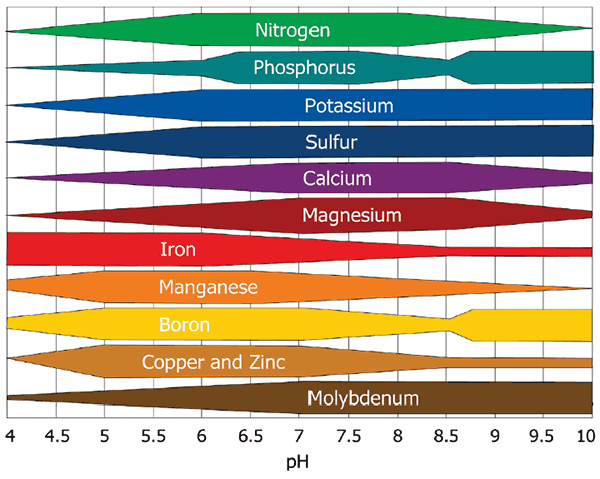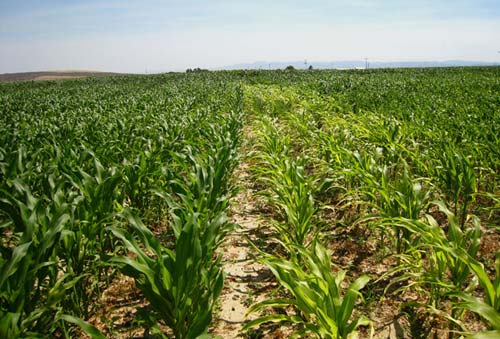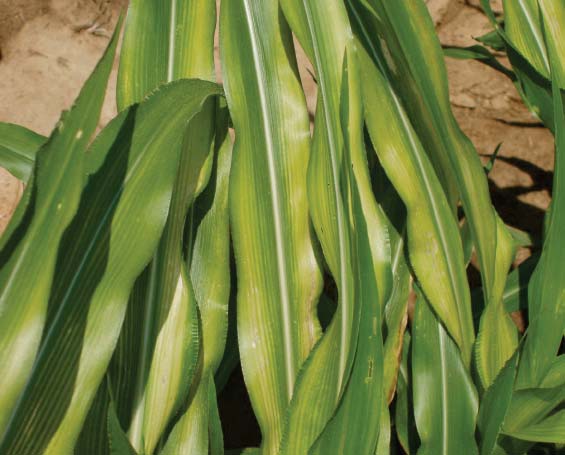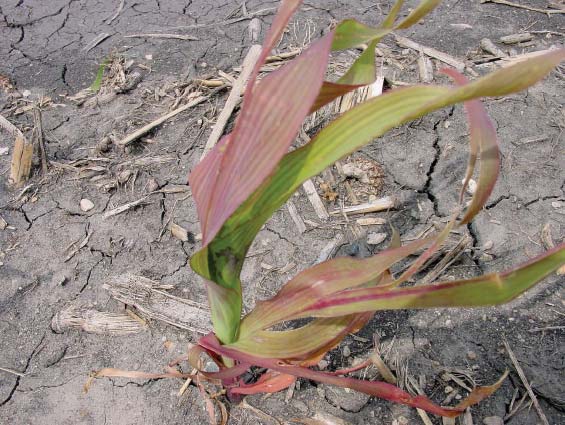Summary
- Management of high soil pH is necessary to grow healthy corn as soil pH affects many processes necessary for crop growth and yield.
- All micronutrients, with the exception of molybdenum, decrease in availability as the pH increases above 7.5 in the soil.
- High pH soil conditions can restrict corn’s use of iron, resulting in iron chlorosis.
- Corn is highly sensitive to zinc. There is a high probability that the crop will respond positively to applied zinc in the case of low soil zinc availability or if the soil has a pH greater than 7.3.
- At soil pH levels from 7.2 to 8.5, phosphorus becomes unavailable to plants because it fixes as insoluble calcium phosphates.
Introduction
Soil pH is a measure of the relative acidity or alkalinity of the soil solution and is expressed on a 14-point scale. Soil acidity increases as pH drops below 7 (neutral pH), and soil alkalinity increases as pH increases above 7. Alkaline soils may be naturally occurring or can be caused by over-liming or by using high pH irrigation water in arid areas. Management of high soil pH is necessary to grow healthy corn as soil pH affects many physical, chemical, and biological reactions necessary for crop survival, growth, and yield.
Micronutrient Relationship to Soil pH
Plants require 16 essential elements for growth and development. Seven are classified as micronutrients because they are used in very small amounts. For most, corn crop uptake is less than one pound per acre (1.1 kilogram/hectare) per year (Table 1). Natural inputs of chlorine come mainly from weather and other physical processes. Micronutrient availability can be severely limited by soil pH and result in poor corn growth.
Table 1. Estimates of micronutrient uptake by corn.
| Micronutrient | 200 bu Corn lbs/acre |
12.5 mt/ha (kg/ha) |
|---|---|---|
| Iron | 2.4 | 2.7 |
| Manganese | 0.4 | 0.4 |
| Zinc | 0.4 | 0.4 |
| Boron | 0.2 | 0.2 |
| Copper | 0.1 | 0.1 |
| Molybdenum | 0.01 | 0.01 |
Adapted from: Role of Micronutrients in Efficient Crop Production, D.B. Mengel, Purdue University AY-239.
All micronutrients, with the exception of molybdenum, decrease in availability as the pH increases above 7.5 in the soil (Figure 1). Higher pH can limit the solubility of many nutrients and, as a result, these micronutrients are precipitated as solid materials that the plant cannot use. For example, the solubility of iron, a limiting micronutrient for growth, is high at low pH but drops drastically at pH values above 7.5, creating an iron-deficient environment unable to support optimum plant growth. These conditions occur often in calcareous soils, which are highly alkaline (pH>7) due to the presence of excess calcium carbonate.

Figure 1. Relative availability of plant nutrients by soil pH.*
Diagnosis of Micronutrient Problems
Micronutrient deficiencies generally have an uneven distribution in fields due to management history and natural variation in soils, and visual symptoms of micronutrient deficiencies often occur too late for effective corrective action. Soil tests for pH level can be useful for accurately monitoring problems and are recommended in seeking management solutions. Application of micronutrient fertilizers can also be restricted to deficient areas in order to minimize the risk of exposing plants to an excess of nutrients, which could lead to plant damage (Wortmann et al., 2013)..

Figure 2. Corn plants exhibiting yellow striped leaves from micronutrient deficiency next to corn plants with no symptoms.
Iron Chlorosis
High pH soil conditions can restrict corn’s use of iron, resulting in iron chlorosis. This condition is commonly associated with calcareous soils. Chlorosis can also occur in fields that are poorly drained, high in sodium, and excess salts. Soil iron is considered to be very low when it drops below 2.5 ppm. Interveinal striping on corn will cause young leaves to become white, yellow, or pale green. Soils prone to iron chlorosis often readily flocculate and seal over; therefore, aeration of the soil by breaking the seal can improve early plant growth.
Manure application can help alleviate low soil iron availability, and mapping areas of deficiency is useful for specific application of fertilizer iron. Iron sulfate can also be applied at rates of 50 to 100 lbs of product per acre (55 to 110 kg/ha) (Wortmann et al., 2013). Foliar applications of iron have also been shown to be successful on corn hybrids relatively tolerant of iron chlorosis.
Zinc Deficiencies
Corn is highly sensitive to zinc. There is a high probability that the crop will respond positively to applied zinc in the case of low soil zinc availability or if the soil meets any of the following criteria:
- Possessing a pH greater than 7.3 (calcareous soil)
- Erosion has removed the topsoil
- Leveling or terracing has occurred on the land
- Soils are very sandy with low organic matter content
Zinc levels of 0.8 ppm are adequate for crop growth, but if the soil content of zinc drops to 0.4 ppm or less, a zinc application is highly recommended. The first symptoms of zinc deficiency will be on new leaves with interveinal striping ranging from the base to the tip. White or yellow broad bands will occur on either side of the midrib, but the leaf margins and tips will remain green (Figure 3).

Figure 3. Corn leaves showing zinc deficiency, characterized by interveinal stripes in the center of the leaf and surrounded by green borders against the broad yellow or white bands.
Corn is a good indicator crop of low soil zinc levels. If the corn crop does not exhibit a need for added zinc, other crops are not likely to need zinc fertilizer. The numerous zinc fertilizer products are broken out into categories of varying components, such as inorganics, synthetic chelates, natural compounds, soluble and insoluble products, and other variable sources of zinc. Sources of zinc for fertilization should be chosen on the basis of solubility, cost, ease of application, and residual effects. Soluble sources of zinc are recommended for soils with high pH.
Phosphorus Deficiencies
Phosphorus is an essential macronutrient for healthy plants as it plays a role in creating plant structural components, biochemical reactions, and photosynthesis. Phosphorus is often less available to the plant in calcareous soils resulting from reactions with calcium. At soil pH levels from 7.2 to 8.5, phosphorus becomes unavailable to plants because it fixes as insoluble calcium phosphates.
Phosphorous deficiency is commonly associated with a reddish-purple coloring of corn leaves and stems that can cause stunted or small plants early in the growing season (Figure 4). Purpling of corn may not be the sole indication that the soil is lacking phosphorous. Conduct a soil test to confirm phosphorous and pH levels. For soils testing below 15 ppm, phosphorous fertilizer application is strongly recommended to build up levels available to corn (Shaver, 2014).

Figure 4. Corn seedling showing purple color due to phosphorus deficiency.
Rock phosphate, water soluble phosphate, and dry phosphate are different sources of fertilizer that are available for application. A liquid polyphosphate, however, can have some additional benefits as it can increase the availability of some other micronutrients in the soil. A grower should choose a fertilizer based on the cost of its nutrient content and the moisture content available to dissolve dry fertilizers. Organic sources of phosphorous are also abundantly available in crop residues, which will return to the soil by late fall. Manure is also a source of phosphorus, but nutrient content can vary widely among different manure types (always test manure for nutrient composition). Application methods, such as banding phosphorous fertilizer, can increase fertilizer effectiveness.
Management Recommendations
General tips to manage high pH include:
- Aggressive utilization of starter fertilizer.
- Manure application to areas with known micronutrient issues.
- Limiting early water applications, if possible, to keep soils from sealing over (Wet soils also lead to more bicarbonate uptake in the seedling root system, which can effectively block the uptake of other nutrients like phosphorous, iron, and zinc.)
Hybrid Selection
A strong preliminary defense against high soil pH levels is specific hybrid placement:
- Select corn hybrids that show optimum yield performance.
- Select corn hybrids that can maintain acceptable plant and ear height.
- Select corn hybrids that can tolerate elevated soil pH levels.
- Visit with your local Pioneer Sales Representative or Dealer for information on Pioneer® brand corn hybrid options.
References
- Truog, E. 1946. Soil reaction influence on availability of plant nutrients. Soil Science Society of America Proceedings 11, 305-308.
- Mengel, D.B. Role of micronutrients in efficient crop production. Purdue University Cooperative Extension Service. Bulletin AY-239.
- Shaver, T.M., ed. Nutrient management for agronomic crops in Nebraska." The University of Nebraska: Institute of Agriculture and Natural Resources EC155 (2014): n. pag. University of Nebraska Extension, 2014.
- Wortmann, C.S., R.B. Ferguson, G.W. Hergert, C.A. Shapiro, and T.M. Shaver. Micronutrient management in Nebraska. NebGuide G1830. Jan. 2013.
*Adapted from Truog, 1946.
PIONEER® brand products are provided subject to the terms and conditions of purchase which are part of the labeling and purchase documents.
The foregoing is provided for informational use only. Please contact your Pioneer sales professional for information and suggestions specific to your operation. Product performance is variable and depends on many factors such as moisture and heat stress, soil type, management practices and environmental stress as well as disease and pest pressures. Individual results may vary.